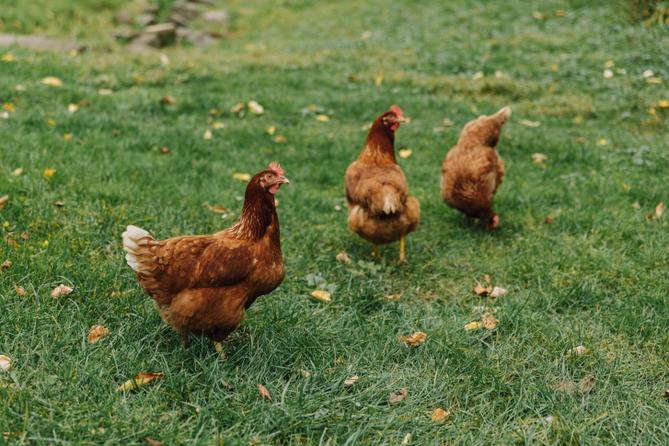BELLEFONTE — Pennsylvania has given $13.5 million to hundreds of farmers over the past three years to help them pay for bird flu testing, recover lost revenue, and implement biosecurity measures.
These are the tentpoles of the state’s special grant program helping farmers respond to the aggressive virus, which is known for devastating flocks and driving up consumer prices.
In 2025, avian influenza has so far been detected at commercial farms in Cumberland, Dauphin, Lancaster, Lebanon, and Lehigh Counties. It originates among wild birds, such as ducks and geese, who often show no signs of illness.
When contracted by backyard and commercial fowl, however, the virus can cause sudden illness and kill otherwise healthy poultry.
In the past month, more than 2.2 million birds have been affected by the virus statewide, according to the most recent federal data.
In March 2023, Pennsylvania had the highest number of cases among all commercial birds and backyard flocks nationwide. Those numbers went down by August 2023. Ernest Hovingh, director of Penn State’s Animal Diagnostic Laboratory, credited collaboration between government agencies and farmers for helping quell cases statewide.
“I think the Pennsylvania poultry industry is very aware of the risks, so they’re doing their best to try and prevent their birds from being exposed to wild birds or to people coming from other farms that might have been infected,” he told Spotlight PA. “Other states are doing similar things, but some of it is the luck of the draw.”
Positive cases and outbreaks in surrounding states mean “the threat is clear and heightened,” state Secretary of Agriculture Russell Redding said in a statement. The virus has hit hard out West — even infecting dairy cattle — and resulted in reduced production, industry losses, and higher costs for consumers.
Though rare, people can contract bird flu — which spreads through direct contact with an infected animal or their droppings — and most human cases have been mild. However, a 65-year-old patient hospitalized with the virus died in Louisiana. The individual had underlying medical conditions, the state’s health department said.
It’s safe to consume properly cooked poultry products, as well as pasteurized milk.
Pennsylvania’s Department of Health monitors for the disease, but the agency’s current role primarily focuses on education. If a person were to contract bird flu, the department would monitor their status and conduct contact tracing.
The state Department of Agriculture leads the response within the industry. The Game Commission also plays a role by tracking and testing wild birds, and got involved when roughly hundreds of snow geese in Lehigh and Northampton Counties were found dead earlier this winter.
To respond to cases in Pennsylvania, state officials rely on guidance from the U.S. Department of Agriculture’s so-called Red Book on highly pathogenic avian influenza infections, which was last updated in May 2017.
Bird flu is almost always fatal to domestic poultry, so infected birds are euthanized and disposed of through a process monitored by a state and federal interagency task force. The U.S. Department of Agriculture compensates farmers for some of their losses, and the state recovery fund aims to handle expenses not covered by the federal government.
A farm with a presumed positive case is quarantined. The task force also tests and implements movement restrictions for all commercial poultry facilities within a roughly 6-mile radius and dairy farms within a nearly 2-mile radius.
Although avian influenza is common among wild birds, there seems to be an uptick in deaths among migratory ones, likely due to this particular mutation, Hovingh said.
“The virus has to run its course in the wild birds. You can’t do a whole lot about the wild bird population, so to speak,” he said.
Genomic testing, which looks at the genetic code of the virus, has helped experts track the spread and mutations, Hovingh said.
But biosecurity and continued testing are the best tools to prevent the virus from finding its way onto farms, he added.
If a farmer suspects their poultry is infected, they must contact the state Department of Agriculture, which takes calls around the clock, at 717-772-285. An on-call veterinarian will respond and evaluate the birds.
Being able to test for bird flu requires a simple certification that’s often encouraged for farmers, said Chris Herr, executive vice president of PennAg, an agribusiness trade association.
Tests, which are free for farmers, go to a facility within Pennsylvania’s three-lab Animal Diagnostic Laboratory System and are later confirmed by a federal lab. Last year, the state mandated bulk testing of milk for bird flu, which monitors dairy cattle for the disease at no cost to farmers.
The state’s labs tested more than 207,000 poultry samples last year. Since November 2024, when the state implemented bulk milk testing requirements, more than 17,000 samples have been tested at no cost to farmers. Shapiro’s $51.4 billion spending plan includes $2 million for an animal testing lab in Western Pennsylvania, which was established in last year’s budget but is not yet open.
To help with testing efforts, Pennsylvania lawmakers approved legislation eliminating a citizenship requirement for certified poultry farmers, who are professionals that can test birds for disease on farms. Shapiro signed the bill, which requires technicians to be 18, legally allowed to work in the United States, and take a training course.
Lawmakers said the bill was the result of advocacy from poultry farmers and the agriculture department, and hope that letting more people test for bird flu helps curb the spread.
Biosecurity includes limiting access to birds, keeping areas clean, and washing equipment. Money from the state bird flu grant program can be used to cover lost revenue, buy coveralls, disinfectants, and construction materials needed to keep wild birds away from poultry.
These measures help protect from infection, but it’s not foolproof.
“You can do absolutely the best you can,” Hovingh said, “but accidents still happen.”

